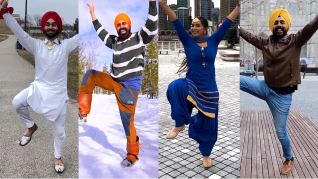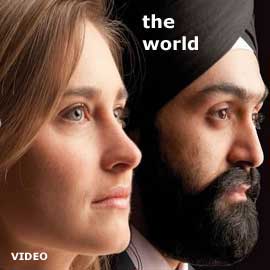
Thumbnail from Video Titled: "Gurdeep Pandher celebrates Sikh Heritage Month with bhangra dancers from across Canada"
Current Events
Gurdeep Pandher celebrates Sikh Heritage Month with bhangra dancers from across Canada
Chris DartThere are very few places where Gurdeep Pandher won't dance bhangra.
Over the past several years, the Yukon-based teacher, author and bhangra dancer has gained renown for performing the traditional folk dance of his native Punjab in the picturesque landscape of his adopted home outside Whitehorse, in forests and on frozen lakes. But he's also danced with minor hockey teams, danced bhangra to traditional Indigenous drumming, tried bhangra-Scottish highland dance fusion, and taught members of the Canadian Forces how to bhangra. The last of those gave us the surreal image of soldiers dancing bhangra in front of a burning helicopter. (It was after a firefighting drill.)
He's had several of his videos go viral, and CBC North called him "arguably the most famous living Yukoner right now." He has over 199,000 followers on Twitter and nearly 46,000 on Instagram, and has been featured on CTV, CBC, Radio-Canada, ITV in the U.K. and MSNBC in the U.S.
In some ways, his rise to fame seems unlikely — but in others it makes perfect sense. Bhangra is a joyful, celebratory dance, and there's something about seeing Pandher do it in the most unlikely places, and with all types of people, that gives us the kind of dopamine hit we've all needed over the last several years.
In his latest video for CBC Arts, Pandher invited other Bhangra dancers across the country to collaborate for Sikh heritage month.
What inspired you to make this video?
As members of the Sikh community, we are thrilled to be having Sikh Heritage Month in April. I wanted to celebrate by inviting members of the community who are dancers to join me. Harkirat Kaur, from Vancouver, said that she would love to be part of this project. Manjinder Singh Pharmah, from Toronto, also happily said that they would be part of this work. And then Harshjot Nijher, from Montreal. So the hope from all of us is to celebrate and to raise awareness about this month.
Talk to me a bit about bhangra, its history and its importance to the Sikh community.
It is the traditional folk dance of Punjab, performed after harvesting the wheat crop in April. In Canada, I think we harvest the wheat crop in fall, but over there we harvest the wheat crop in April. So, people started dancing Bhangra to express their joy and also to express their gratitude to the land for providing the bumper crop. April is also the month of Vaisakhi. You probably know that Vaisakhi is celebrated on April 13 by the Sikh community as the birth of Khalsa.
I'd also like to make a distinction which is important. Bhangra doesn't have much connection with Sikhism as a religion. You won't find people doing bhangra in Sikh gurdwaras. But you would find Sikh people dancing bhangra during weddings or other kinds of celebrations. So it has become part of Sikh culture, but it's not associated with Sikhism
So how has bhangra changed from being a harvest dance to what we see today, where there are competitive bhangra teams?
If you look at the dance, it's gone in a very modern direction. And sometimes someone like me, a dancer who does a more traditional form of dancing — we do not necessarily approve of that style. Both the lyrics are not, in modern days, very meaningful, and the dancing has become more trendy with the arrival of modern music. But the good news is that this [style] also raises some awareness [of bhangra]. Now, some dancers, some singers, have also started following traditional ways of dancing.
Our elders used to dance to the dhol drum. You can add some other instruments too, but the dhol drum stays predominant. And traditionally, bhangra is danced in open spaces and in natural settings, because originally it was created in open spaces, like in the open farmlands of Punjab. So it has a very deep connection to the land.
Just like we see in Canada, Indigenous dancers have a deep connection with land in a similar way. We say thank you to the land for providing. So when people dance or drum in nature, it feels like the traditional way of dancing. As I said in the beginning, bhangra was becoming more like dancing to trendy songs. But now people are turning back to more traditional styles.
Where can people outside the Punjabi or Sikh community find out more about bhangra and also Punjabi culture in general?
Sarabjit Cheema is a great dancer and also a singer. He is one of the role models. Another name is Pammi Bai; he's also a musician and singer as well, and also a great dancer. And then authors like Bhai Vir Singh, Nanak Singh, Gurbax Singh Preetlari — these people wrote about the villages of Punjab, the folklore of Punjab, and the culture and heritage of Punjab. They brought the culture outside through their books and they presented it in a beautiful way. They speak to local native Punjabi people and they brought their voices out.
Anything else you want to add?
I would say that dance is a great connector. We all know that we have a lot of polarization in our modern day society. So through dancing — this positive expression — it has become a really great medium for me to gather people on one stage. Because when people are positive and people are happy, they connect more with each other.
This interview has been edited for length and clarity.
[Courtesy: CBC]
April 01, 2022


